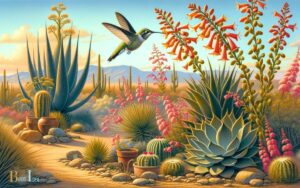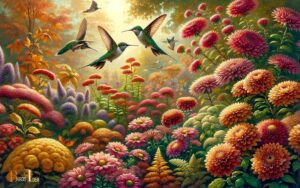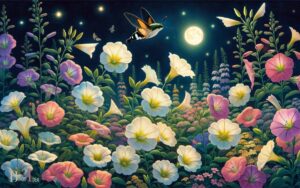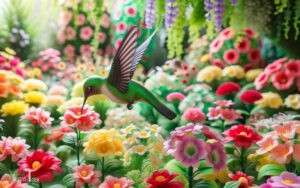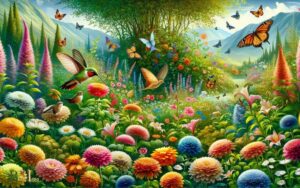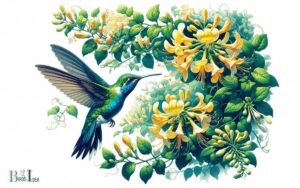How to Attract Hummingbirds to Nest? 9 Strategies!
To attract hummingbirds to nest, provide a habitat with native flowering plants, a water source, and safe nesting materials.
Avoid pesticides, ensure shelter from predators, and consider a hummingbird feeder with nectar as a supplemental food source.
Hummingbirds look for specific criteria when choosing a nesting site:
Create a hummingbird paradise by simulating their natural habitat with flowers, water, and safety.
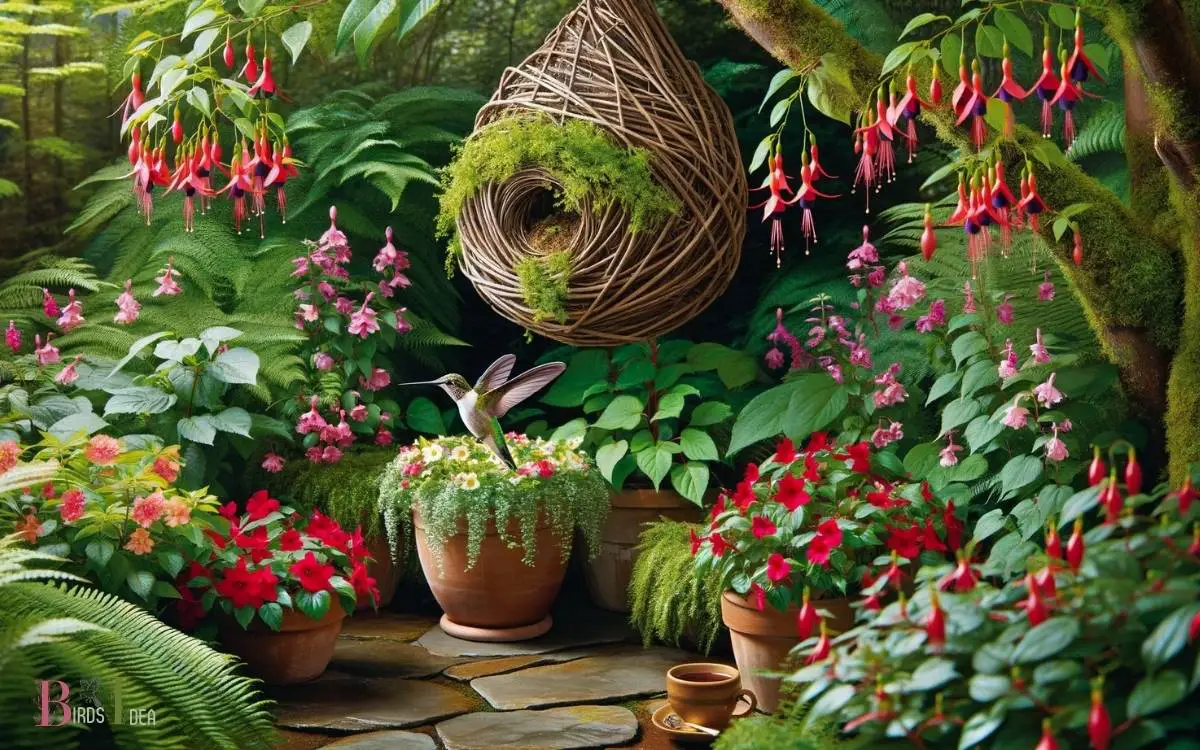
Key Takeaway
9 Strategies to Attract Hummingbirds to Nest
| Strategy | Description | Additional Tips |
|---|---|---|
| Plant Native Flowering Plants | Choose native plants that produce nectar, such as bee balm, columbine, and trumpet vine. | Hummingbirds are attracted to red and tubular-shaped flowers. |
| Maintain Continuous Blooming Cycle | Ensure a variety of plants that bloom at different times during the hummingbirds’ nesting season. | This provides a consistent nectar source for hummingbirds. |
| Add a Hummingbird Feeder | Supplement natural nectar sources with a feeder filled with sugar water. | Change the water every few days to prevent mold and bacteria growth. |
| Provide Perches | Include thin branches or wires for hummingbirds to rest and watch over their territory. | Place perches near feeding areas but in a sheltered location. |
| Avoid Pesticides | Refrain from using pesticides in your garden as they can harm hummingbirds and their food sources. | Opt for natural pest control methods to protect the birds. |
| Offer Nesting Materials | Provide materials like moss, lichen, and spider silk for nest building. | Place materials in accessible locations but not too close to busy areas to avoid disturbing nests. |
| Ensure Water Availability | Install a birdbath or misters for hummingbirds to bathe and hydrate. | Keep the water source clean and change the water regularly. |
| Create a Safe Environment | Keep cats and other predators away from areas where hummingbirds frequent. | Consider placing feeders and plants in higher, more secluded areas. |
| Avoid Using Red Dye | Use clear sugar water in feeders instead of red dye, which can be harmful to hummingbirds. | A ratio of 1 part sugar to 4 parts water mimics natural nectar |
Understanding Hummingbird Behavior
Understanding Hummingbird Behavior involves observing their feeding, mating, and nesting habits. Hummingbirds have a unique feeding behavior, requiring them to consume their body weight in nectar each day.
They are also attracted to brightly colored, tubular flowers, and feed by hovering in front of them using their remarkable flying abilities.
When it comes to mating, male hummingbirds perform elaborate aerial displays to attract females, showcasing their vibrant plumage and agility.
After mating, female hummingbirds meticulously select a suitable nesting site, often choosing well-concealed locations to protect their eggs from predators.
Their nesting habits involve weaving intricate structures using spider silk and plant material, ensuring a secure environment for their offspring.
Understanding these behaviors is crucial for creating an environment that attracts and supports hummingbirds through their nesting process.
Selecting the Right Nesting Materials
Hummingbirds select nesting materials based on their durability and flexibility, enabling them to create secure and adaptable structures for their offspring.
When attracting hummingbirds to nest, it’s important to provide the right materials to support their nesting process.
Here are some key points to consider:
Natural Materials
- Soft plant fibers, such as cattail or milkweed down, provide excellent insulation and cushioning for the nest.
- Mosses and lichens can be used to camouflage the nest, providing additional protection for the eggs and young chicks.
Planting Hummingbird-Friendly Flora
To further support the nesting process, it is essential to plant hummingbird-friendly flora that offers a diverse array of nectar-rich blooms and natural materials for nesting.
When choosing plants, it’s important to select a variety that blooms at different times throughout the year, providing a continuous nectar source.
Native flowers like bee balm, columbine, and trumpet vine are excellent choices as they attract hummingbirds with their vibrant colors and abundant nectar.
Additionally, incorporating shrubs such as azaleas and rhododendrons provides ideal nesting locations. These plants offer sturdy branches and foliage for hummingbirds to build their nests.
By creating a diverse and welcoming environment with these flora, individuals can significantly enhance the likelihood of attracting nesting hummingbirds to their outdoor spaces.
Providing Adequate Shelter and Protection
When it comes to attracting hummingbirds to nest, providing adequate shelter and protection is crucial. This includes creating a safe environment that shields them from predators and ensuring that there is an abundance of nesting material available.
By addressing these key points, individuals can increase the likelihood of hummingbirds choosing to nest in their surroundings.
Sheltering From Predators
Attracting hummingbirds to nest requires providing adequate shelter and protection from predators.
When it comes to sheltering from predators, it’s important to consider the following:
- Strategic Placement: Positioning the hummingbird nest in a location that is difficult for predators to access, such as high up in a tree or under the eaves of a building, can greatly reduce the risk of predation.
- Natural Barriers: Introducing natural barriers, such as thorny plants or dense foliage, around the nesting area can act as a deterrent to predators, making it harder for them to reach the nest.
Nesting Material Availability
In ensuring adequate shelter and protection for nesting hummingbirds, it is important to provide a variety of nesting materials.
Hummingbirds use a range of materials to build their nests, including spider silk, soft plant fibers, and feathers.
These materials help create a secure and comfortable environment for their eggs and young. Consider hanging a mesh bag filled with pet fur or natural cotton near their nesting areas.
Additionally, providing small sticks and moss can offer essential building blocks for their nests. It’s also helpful to place these materials in sheltered areas, such as under an overhang or near dense foliage, to protect them from the elements and potential predators.
By offering a diverse selection of nesting materials in protected locations, you can greatly increase the chances of attracting hummingbirds to nest in your yard.
Maintaining a Clean and Safe Environment
Hummingbirds require a clean and safe environment to feel secure and thrive.
To maintain such an environment, individuals should follow these guidelines:
Regular Cleaning
- Clean feeders and nesting areas frequently to prevent the growth of mold and bacteria, which can be harmful to hummingbirds.
- Remove any debris, old nesting material, or droppings from the vicinity to minimize the risk of parasites and diseases.
Ensuring a clean and safe environment is crucial for the health and well-being of hummingbirds. By adhering to these guidelines, individuals can create an environment that supports the thriving of these magnificent birds.
Implementing Water Sources
When it comes to attracting hummingbirds to nest, providing water sources is crucial. Hummingbirds need water not only for drinking but also for bathing and keeping their plumage clean.
Different types of water features, such as misters, drippers, or shallow dishes, can be implemented to cater to their water needs.
Water for Hummingbirds
Hummingbirds are attracted to a variety of water sources in the garden. Providing water is essential for their hydration and bathing needs.
To implement water sources effectively, consider the following:
Birdbaths:
- Place shallow birdbaths with gently sloping edges to allow hummingbirds to bathe comfortably.
- Keep the water clean and change it regularly to prevent the spread of diseases.
Misters and Drippers:
- Install misters or drippers near hummingbird-friendly plants to simulate natural dew and attract hummingbirds.
- Ensure that the water droplets are fine enough to be easily dispersed by the wind.
Types of Water Features
Attract hummingbirds with an array of water features, such as birdbaths and misters, to provide essential hydration and bathing opportunities.
Birdbaths are a popular choice and should be shallow, allowing hummingbirds to access the water easily.
Adding a small fountain or dripper to the birdbath can create movement that attracts hummingbirds.
Misters are another effective water feature, providing a fine spray of water that hummingbirds enjoy flying through.
A simple mister system can be set up with a hose and a mister attachment, creating a refreshing environment for the hummingbirds.
Additionally, ponds or small water gardens with shallow edges can serve as natural water sources.
These water features not only attract hummingbirds but also contribute to a thriving ecosystem in the garden.
Monitoring Hummingbird Nesting Activity
To monitor hummingbird nesting activity, set up a designated observation area with a clear line of sight to potential nesting sites. This area should be at a safe distance to avoid disturbing the birds.
Here are some tips for monitoring hummingbird nesting activity:
- Use binoculars: Binoculars can help you observe nesting sites from a distance without causing any disturbance to the hummingbirds.
- Choose a pair with good magnification: Opt for binoculars with a magnification of at least 8x to clearly observe the nesting behaviors without getting too close.
- Keep a journal: Maintain a journal to record observations of nesting behavior, including dates, times, and any notable activities such as nest building or feeding. This will help you track the progress of nesting activity over time.
Conclusion
Creating a hummingbird haven in your backyard is like painting a beautiful masterpiece.
By understanding their behavior, selecting the right materials, planting hummingbird-friendly flora, providing shelter and protection, maintaining a clean environment, implementing water sources, and monitoring their nesting activity, you can attract these vibrant creatures to nest in your garden.
It’s like setting the stage for a magical performance, where the hummingbirds are the star performers, bringing joy and beauty to your outdoor space.

